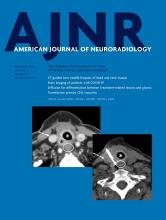Research ArticleAdult Brain
Open Access
Maximum AmbiGuity Distance for Phase Imaging in Detection of Traumatic Cerebral Microbleeds: An Improvement over Current Imaging Practice
K. Nael, J.C. Dagher, M.E. Downs, M.S. Fine, E. Brokaw and D. Millward
American Journal of Neuroradiology November 2020, 41 (11) 2027-2033; DOI: https://doi.org/10.3174/ajnr.A6774
K. Nael
aFrom the David Geffen School of Medicine (K.N.), University of California, Los Angeles, Los Angeles, California
J.C. Dagher
bEmerging Technologies (J.C.D., M.E.D., M.S.F., E.B.), MITRE Corporation, McLean, Virginia
M.E. Downs
bEmerging Technologies (J.C.D., M.E.D., M.S.F., E.B.), MITRE Corporation, McLean, Virginia
M.S. Fine
bEmerging Technologies (J.C.D., M.E.D., M.S.F., E.B.), MITRE Corporation, McLean, Virginia
E. Brokaw
bEmerging Technologies (J.C.D., M.E.D., M.S.F., E.B.), MITRE Corporation, McLean, Virginia
D. Millward
cAthletics Department (D.M.), University of Arizona, Tucson, Arizona

References
- 1.↵Centers for Disease Control and Prevention. Surveillance Report of Traumatic Brain Injury-related Emergency Department Visits, Hospitalizations, and Deaths—United States, 2014. 2019. https://www.cdc.gov/traumaticbraininjury/pdf/TBI-Surveillance-Report-FINAL_508.pdf. Accessed March 29, 2019
- 2.↵
- Thurman DJ,
- Alverson C,
- Dunn KA, et al
- 3.↵
- Xi G,
- Keep RF,
- Hoff JT
- 4.↵
- Hughes DG,
- Jackson A,
- Mason DL, et al
- 5.↵
- Scheid R,
- Preul C,
- Gruber O, et al
- 6.↵
- Fazekas F,
- Kleinert R,
- Roob G, et al
- 7.↵
- Goos JD,
- van der Flier WM,
- Knol DL, et al
- 8.↵
- Greenberg SM,
- Vernooij MW,
- Cordonnier C, et al
- 9.↵
- Uetani H,
- Hirai T,
- Hashimoto M, et al
- 10.↵
- 11.↵
- 12.↵
- 13.↵
- 14.↵
- Haacke EM,
- Xu Y,
- Cheng YC, et al
- 15.↵
- 16.↵
- 17.↵
- Cordonnier C,
- Potter GM,
- Jackson CA, et al
- 18.↵
- Chen JK,
- Johnston KM,
- Collie A, et al
- 19.↵
- Keenan KE,
- Berman BP,
- Carnicka S, et al
- 20.↵
- 21.↵
- Scheid R,
- Walther K,
- Guthke T, et al
- 22.↵
- Ayaz M,
- Boikov AS,
- Haacke EM, et al
- 23.↵
- 24.↵
- Tong KA,
- Ashwal S,
- Holshouser BA, et al
- 25.↵
- Nandigam RN,
- Viswanathan A,
- Delgado P, et al
- 26.↵
- 27.↵
- 28.↵
In this issue
American Journal of Neuroradiology
Vol. 41, Issue 11
1 Nov 2020
Advertisement
K. Nael, J.C. Dagher, M.E. Downs, M.S. Fine, E. Brokaw, D. Millward
Maximum AmbiGuity Distance for Phase Imaging in Detection of Traumatic Cerebral Microbleeds: An Improvement over Current Imaging Practice
American Journal of Neuroradiology Nov 2020, 41 (11) 2027-2033; DOI: 10.3174/ajnr.A6774
0 Responses
Jump to section
Related Articles
- No related articles found.
Cited By...
- No citing articles found.
This article has not yet been cited by articles in journals that are participating in Crossref Cited-by Linking.
More in this TOC Section
Adult Brain
Similar Articles
Advertisement











